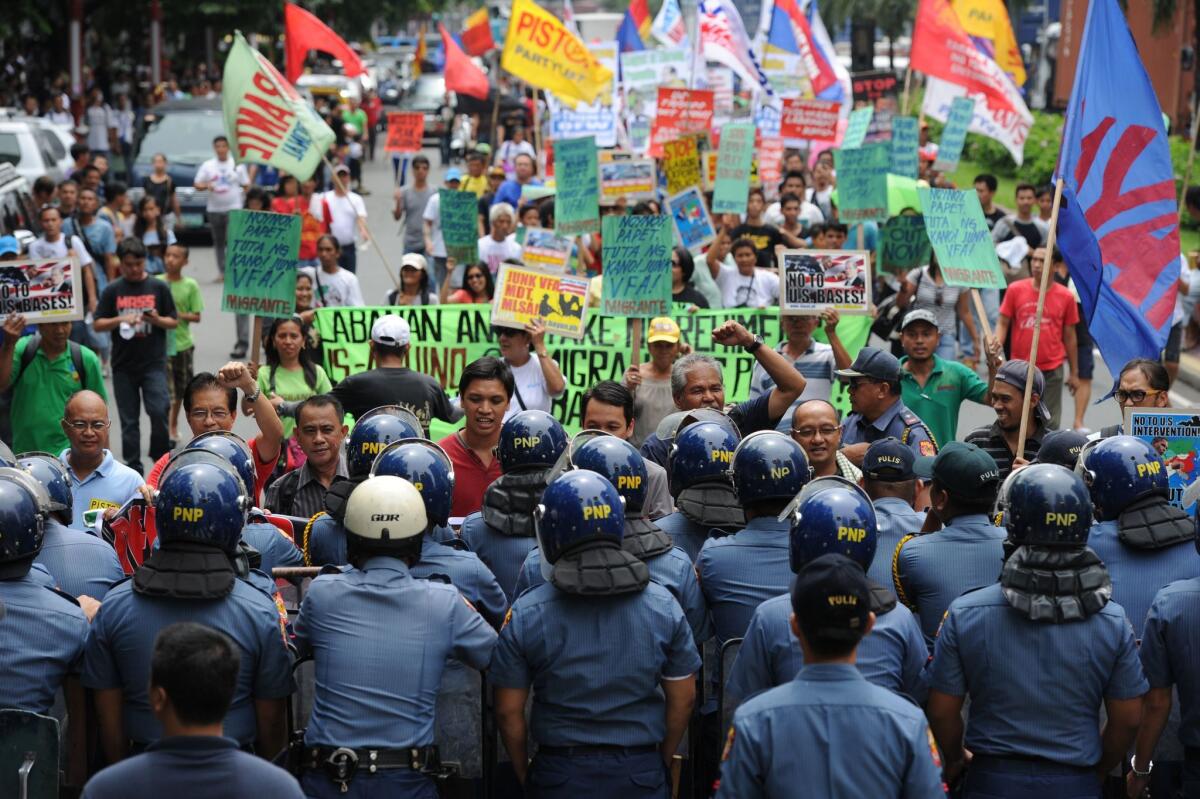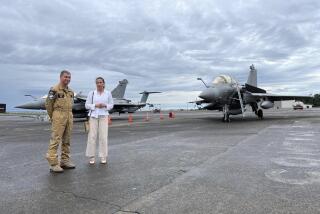Philippine leaders want U.S. troops back as bulwark against China

- Share via
More than 20 years after Philippine officials shut down U.S. military bases amid rising anti-American sentiment, the Manila government has announced that it will soon be negotiating with Washington to increase its military presence in the region as a counterweight to domineering China.
Tens of thousands of U.S. troops were stationed in the Philippines after it was liberated from Japanese occupation after World War II. The giant bases that harbored U.S. sailors and airmen, Subic Bay Naval Station and Clark Air Force Base, were shuttered by the end of 1992. A constitution written shortly after the Americans were pushed out now forbids any permanent foreign military presence in the islands that were once a U.S. colony.
Under a 2002 agreement between the United States and the Philippines, several hundred U.S. counter-terrorism troops have been in the country to train Philippine soldiers for operations to contain Al Qaeda-allied insurgents plaguing the southern island of Mindanao. The Visiting Forces Agreement limits the troops’ number and length of stay.
“The Philippines will shortly enter into consultations and negotiations with the United States on a possible framework agreement that would implement our agreed policy of increased rotational presence,” Defense Minister Voltaire Gazmin and Foreign Minister Albert del Rosario announced in a letter released to news media in the region Thursday.
Del Rosario told reporters at a Manila news conference that he hoped the talks would begin as soon as possible to work out the “modalities and parameters” necessary to beef up the U.S. presence in the country.
The Philippines, like other U.S.-allied Asian nations, has been confronted in recent years by an increasingly aggressive China that has laid claim to disputed islands and resources in the East and South China seas. Japan, Taiwan, South Korea, Brunei, Vietnam and Malaysia also are engaged in tense standoffs with Beijing over natural assets in the region.
Gazmin said the increased U.S. presence was desired “for the protection of our West Philippine Sea,” the name Filipinos use for the South China Sea waters surrounding disputed islands, fishing grounds and rich oil and natural gas deposits.
Philippine ships last year were forced to back off from their traditional fishing area at Scarborough Shoal after Chinese sailors erected a barricade to block entrance to the disputed waters.
The Associated Press in Manila reported Thursday that it had seen confidential Philippine military surveillance reports that 61 Chinese vessels had been sighted over a six-day period last month off the disputed Spratly Islands. China since 1995 has also occupied the Mischief Reef, which Manila also claims, and it has converted it to a base for Chinese patrol vessels.
Philippine President Benigno Aquino III made clear last month that the expanded deployments would remain temporary and that the visitors would have to operate from existing Philippine national bases and not reopen or rebuild their own.
The Philippines was a U.S. colony from 1898 until it was granted partial autonomy in 1935. It was occupied by Japan during World War II, and its sovereignty was recognized by the United States in 1946.
It was unclear from the announcements how soon the two sides might sit down to hammer out an agreement to expand the number of U.S. forces in the Philippines, nor were any target figures mentioned. But the Philippines’ desire for more protection from an ascendant China dovetails with the United States’ plans for a “pivot to Asia,” in which it hopes to relocate defense resources from Europe and the Middle East to enhance its clout in the region.
ALSO:
2 British women attacked with acid in Zanzibar
Israel advances 1,100 settlement units despite peace talks
In Nairobi’s airport fire, looting and big tourism losses for Kenya
Twitter: @cjwilliamslat
More to Read
Sign up for Essential California
The most important California stories and recommendations in your inbox every morning.
You may occasionally receive promotional content from the Los Angeles Times.











